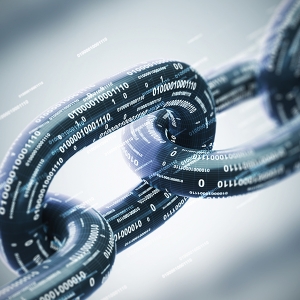The Blockchain technology simply explained
 28.02.2019 -
The term blockchain has become more and more common in the working world of project managers in recent years. But what exactly is it all about? Many online articles explain the term, but often every third word is a foreign word, which in turn has to be explained in another article. So we try to find a simple explanation: what is the blockchain?
28.02.2019 -
The term blockchain has become more and more common in the working world of project managers in recent years. But what exactly is it all about? Many online articles explain the term, but often every third word is a foreign word, which in turn has to be explained in another article. So we try to find a simple explanation: what is the blockchain?Neutral and independent databases
The blockchain is actually a database that records actions between two partners and displays all changes transparently. It is a decentralized database, i.e. a database that is located on many different servers and cannot be found in your own company or anywhere on a particular server. With blockchain there is no owner of the database. Nobody has power of disposal or power over this data. All users have the same rights and possibilities to access it. Blockchain is neutral and processes information independently. The risk of a blockchain being manipulated or hacked only exists when a partner owns more than half of the entire network, which normally does not happen. In such a decentralized system, however, there is no administrator who evaluates or sorts data.
Traceable and constantly controlled
The information that runs through the blockchain is often of a financial nature, but not only. All data is passed to the blockchain and remains unchanged. Nothing can be taken back, but it can always be traced. Everyone can always find out where information came from and what it was. Blockchain is popular because it does not involve paid middlemen such as notaries and cannot be manipulated. Transactions can be carried out directly between all partners. So-called miners always have access to the data and continuously control the journal or protocol of the block chain. These miners are something like the accountants in the blockchain. Information that has been checked and confirmed by a miner remains forever. The name blockchain comes from the fact that so-called blocks form the basis. All data is stored in blocks. However, these must not be larger than 40 bytes. Usually these blocks are contracts, financial transactions, shares or wills. Each block has a history and is linked with other blocks. There are chains of blocks, which led to the term blockchain. To access the blockchain system, you need access software. This is usually called a "wallet" and works like a key. There is a public and a private key. The private key is like a password, which under no circumstances should be given to strangers, and the public key is visible to everyone. The private key is used to sign and verify transactions. The key pairs are specially protected by asymmetric verification.
Application of Blockchain
The application possibilities are very versatile. For example, contracts or securities of all kinds are managed. Transactions and transfers between banks take place in the block chain. Wherever transparency is particularly important, blockchain technology can be applied. Insurance companies use Blockchain to organize their contracts, rules and databases. Insurance companies, for example, use Blockchain to check their customer data and fully automate the conversion of contracts. In the music industry today, Blockchain replaces traditional record contracts and the management of artists' rights to their works is done via Blockchain. Today there is even the possibility for fans to participate in the system and support different artists by distributing music. Various payment systems use Blockchain, such as micropayments and the payment of digital goods or crypto currencies such as Bitcoin. There are ideas to also design voting systems on the blockchain basis so that electoral fraud and manipulation are no longer possible. The country of Honduras has planned to organise its land register entries with a blockchain so that corruption is made more difficult.
Other such projects are also being planned in other countries. The enormous advantage here is that no more people are needed for control, which means that everything is evaluated neutrally and nobody is bribeable anymore. Blockchain could therefore replace many processes in the future and be used in many different areas. Today, where virtually everything can be networked online, Blockchain offers endless possibilities. A database system that cannot be corrupted or manipulated can also have many advantages in project management. Many companies already rely on the technology, but mostly only in certain areas. The development continues and it remains to be seen which functions will be controlled by blockchain in the next few years. Dealing with this topic can only be advantageous.
« Back to overview
